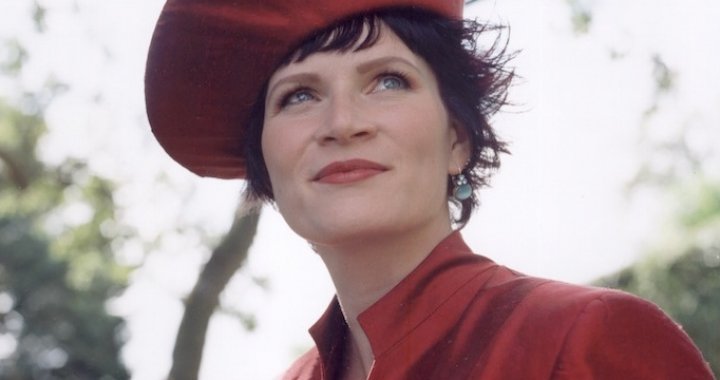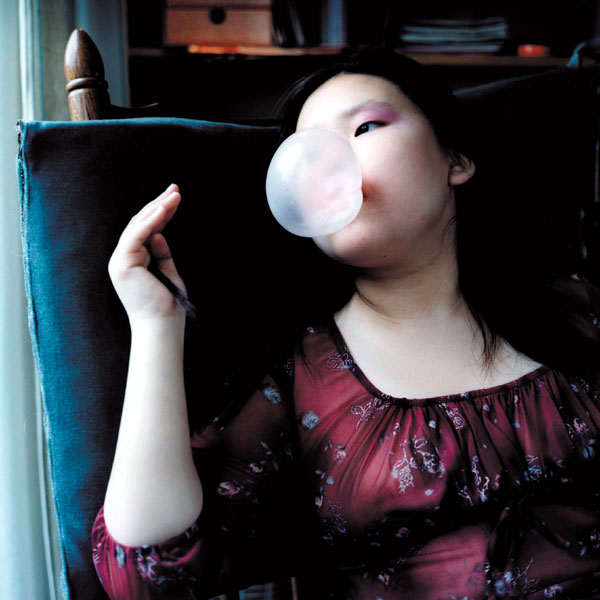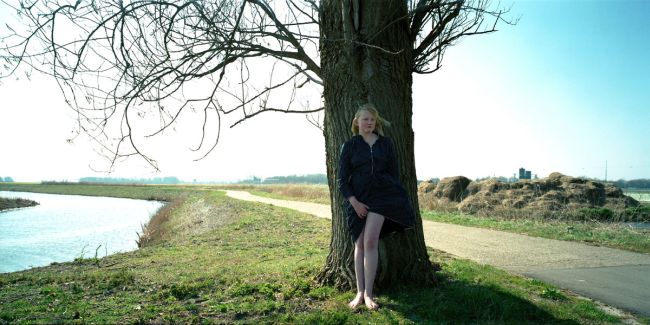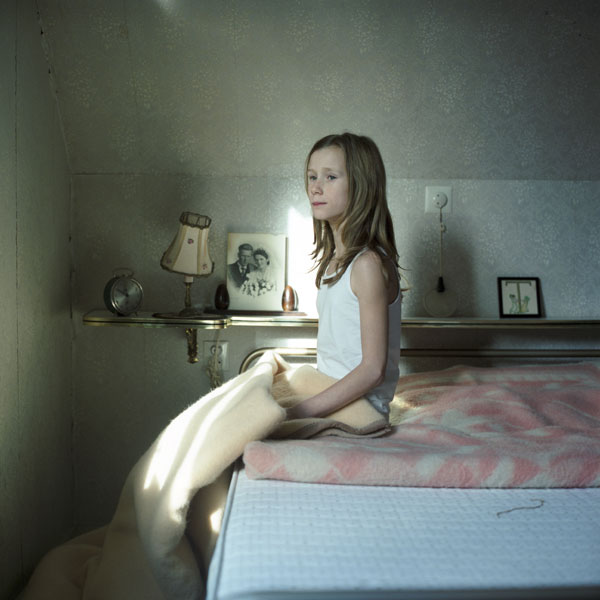
To Straighten the Back Posture of a Teenager
Agnese Čivle
23/08/2012
The works of Dutch portrait photographer Hellen van Meene (1972) have been exhibited around the world – from Amsterdam's city museum, to the Victoria and Albert Museum in London and the Guggenheim in New York City. For over fourteen years now, she has focused her camera on adolescents that she has met during her travels. Usually, these are ordinary girls without any experience of posing in front of a camera. Van Meene's most prominent peculiarity is that she uses only natural light in her photographs, but the language of photography is impossible to explain with a theory. It is about intimacy, emotions, and things that people recognize in themselves, but often try to deny.
It was just last year when something else appeared in van Meene's images for the first time. These were dogs, which the artist had not been particularly fond of till then.
Van Meene lives with her family in the small Dutch city of Heillo, keeps bees, doesn't “hang out” with stars of the art world and if, on the off-chance, she happens to be doing a photo shoot for Tank Magazine, she doesn't stray from her stance and signature way of doing things – the creative team steps aside and the artist has the last word in everything.
Van Meene taught master classes at the International Summer School of Photography, which was held in the Latvian town of Kuldīga during the first two weeks of August 2012. In her interview with Arterritory.com, the artist speaks about the reaction system that takes place when she meets with her model during a photo shoot, as well as after it.

Do you remember how you came to start taking photographs?
I was sixteen years old when I was given a plastic camera as a gift. My brother got a blue one, while I – a pink one. I started taking pictures of my friends. Not long after, I got a better camera and it seems like that's how it all started.
From 1992 to 1996 I studied art photography at the Gerrit Rietveld Academie in Amsterdam; and in 1995, also at the Edinburgh College of Art. At this time I came to understand that, for me, photography is the simplest language in which to express myself – because I don't have a talent for painting. In addition, photography is a very quick means of getting a result, even though I never work in a studio and I only use natural light in my work – with which, as everyone knows, you often have to be patient with waiting for it. The light is perfect only in winter and spring, and also autumn; whereas in the summer, the sun is very high and the light is too strong. Strong light is not always beautiful. It's more complicated in the winter, since there is sunlight for only a short period of time. Which is why, often enough, I have to wait a whole year for the perfect light again.
People frequently compare my photography to painting. That's mostly because artists also use only natural light for their work. That's something we have in common.
However, there is one very important point – when I create my work, I never think about paintings. My source of inspiration is the model. I never judge my models on physical characteristics like thin, fat, short or long hair... There's something more there – a kind of special chemistry.

Could you tell me about this creative mannerism with which you look upon people?
I find my models on the street – among completely ordinary people. It's always a challenge – the ability to see and bring out the beautiful in them. But when I have a person who already is really beautiful in front of the camera – with great skin and wonderful bone structure – that makes the picture-taking process quite boring. The challenge is gone.
When I photograph completely ordinary girls from the street, they tend to blossom, like a flower. Often times at the opening of the show, if the girls are present, the atendees don't even recognize them.
I believe that when taking someone's picture, if special attention, time and effort is given, then the person can become truly, truly beautiful.
Here in Latvia, I saw an old man sitting on a bench by his house. In his face, you could read everything – a life rich with spirit, joy and pain. But for me, a model like this isn't especially inspiring. Why is that? Because this old man is already like a complete story, which can be read from his wrinkly, wizened face. A photograph of this man would explain and reveal too much; whereas in photographs of young people, a seven or eight year-old girl – with her attitude and my photographic language – can become anything, be it someone older, or younger.
Young people have the ability to remind us of many various things, to tell us so many stories, different feelings and associations. A young face is open and free of prejudice, while an old man can no longer become something else. He is what he is. It's the same with a beautiful woman that we see in a magazine. For me, that's boring.
We have so many interesting people around us, we just have to know how to recognize them, give them our attention, and create our photographic language. Of course, the model must be at least slightly photogenic – that's important; however, the people I select already are like that. I see in them something that others, up to now, haven't been able to see.
Is this challenge the impulse that makes you create photographic portraits?
Yes, it is. I tend not to lean towards a conceptual idea; I simply work because I've been inspired by the people around me.
Of course, there are times when I have an idea and I try to find the right girl for it. Sometimes it's very hard, because it's hard to even describe what it is that I'm looking for. I'm looking for a kind of chemistry. Chemistry can be anything. But when I'm traveling, I always happen to meet someone with whom I'm happy to work with.

Tell us how easy, or hard, it is to steer models towards achieving the hoped-for results.
Ninety-nine percent of the time, a photograph turns out exactly the way I wanted it to. That comes easily to me, because I'm very sure of what I want. And I know how to get it. Always and everywhere, I'm watching everything around me; I use my intuition to lead me. A photograph is the result of the interaction between me, and how I compose the model.
In addition, when I'm working, I select every detail very precisely – so that it fits in perfectly with the thoughts in my head. My energy is very concentrated. To get a good result, you can't simply snap all over the place – there must be focus. You can devote a whole day to a picture, simply because the end result is important; but if a person is not suited to a concrete idea...
I give a lot of my energy to the model. The moment I meet somebody, the photograph is beginning to form. Sixty percent of the first meeting is very important, because it's essential that I know early-on if this person is the one that I want to work with.
I also have to be honest, otherwise the person I've approached may think: “Yeah, sure! Take a picture of me!? Why?”. People tend to be unsure of themselves, they even tend to think of themselves as ugly and don't want people to make fun of them. I must be able to get rid of all of this reluctance and timidness. I must know how to create an atmosphere in which we both feel completely comfortable. Even if we don't speak the same language.

What, in your opinion, is your responsibility as a photographer?
When I do shoots with adolescents, they tend to be very awkward and unsure of themselves; their shoulders constantly droop... And it's interesting, because in this way it's possible to show what we once used to be like ourselves.
But I want to show how someone can change, become self-assured and proud of him- or herself. Maybe that's my responsibility.
I never cross the line that would make someone feel uncomfortable, but at the same time, I make them crawl out of their comfort zone and take a risk, to see how far we can go. However, the line must be felt, and my heart can usually tell how far I can push.

Are your works often seen as scandalous?
Andres Serrano, with his “Piss Christ” (1987), is scandalous. That is extreme provocation. My works contain much more gentleness.
In revealing things that have caused doubt and uncertainty in people, I try to show them that they really have nothing to fear or to be ashamed of, because by showing their ability to be wounded, they are very strong.
It is not my goal to make polemic photographs. But if people see them that way... Well, I think they see them that way because eighty percent of them lack confidence in themselves. It's hard for them to look at these photographs because, my God, they're not about fashion... My photographs are about intimacy, about emotions that are sometimes confusing – about things that aren't shown on a daily basis, but everybody knows about them. People recognize these things in themselves and it's difficult for them to accept that. It's always interesting that a photograph tells more about the person looking at it then about the photo itself.
No, I'm not trying to sell something. I photograph ordinary people, who become special in my pictures.

The genre of portrait photography seems as old as the earth itself, but tell me – how does it continue to remain also contemporary?
People think in concepts and create conceptual contemporary art, but when I'm creating, I don't think about that. I live with my family in a very small Dutch city, create my works and don't think about whether they are contemporary; I don't even think about galleries and clients.
Through my window I see wide meadows, cows and bees. About modern, current, contemporary art... I don't think of it in any way or form.
When my works have come so far as to be exhibited, I can sort of step back and look at them from the side-lines... Well, yes, then I can say that that is art. Maybe contemporary art. But, if I thought about that daily, it would be like – as if I'm taking myself too seriously; and to take myself seriously – that's strange: “I'm such an important artist, books are written about me, articles are published...”. No, I don't occupy myself with that. But if someone says something like that to me – thanks for the compliment!

Do you ever think about leaving the genre?
Last year I took pictures of dogs. As if they were people. Dogs are very close to people – even in terms of portraiture.
I've never really liked dogs, I was even scared of them; and then suddenly, dogs took over my thoughts and I had to photograph them. What a shock!
I wondered whether I'll be able to create photographs of dogs that will communicate like the usual Hellen van Meene... Will the photographs be just as powerful as my images of adolescents?... But I created them anyway, and strangely – in working with dogs, I used the same strict selection process that I use with young people. I didn't take pictures of just any dog. No! A golden retriever is like Sandra Bullock – both a beautiful actress and a nice girl-next-door. I didn't want to photograph dogs like that, I didn't want these beautiful specimens; I wanted dogs with character. And I concentrated on this work just like I did when working with people as models.
And there's more... I discovered something that I had never thought about before. When looking back into the history of Dutch painting, there have always been children and dogs. A girl with a dog, children with dogs... So maybe it wasn't all that strange that I began this series. It may seem weird, but that's the way it was meant to be!
Last February I had a show in Japan and New York, and the gallery owners were worried about why has van Meene come out with a series of dogs... in fourteen years of my work doing photography – it was a first!
But the instinct that led me to do it was so strong that I just had to do it. You have to listen to your intuition, follow the voice of your heart... Otherwise you're not an artist, but just doing what is expected of you.
In the shows, we put the dog photographs next to those of the girls, and it seemed that that's the way it should be – that's the way it's always been. Surprising!

In your opinion, is there a trend in today's photography, or maybe a name, that we should turn our attention to?
My husband always keeps track of what's going on out on the web, in art blogs... I don't do anything like that. Of course, I go to exhibitions. But I don't spend too much time on that, because it could take attention away from my own work. I look around at what's going on, but I don't concentrate on it. I live in my own sort of “bubble”.
I don't go to all of those openings, I don't wear the kind of clothes that an artist should... I can't say that I hang out with all of those famous artists, that we inspire each other... I don't care. I don't even want to be one of “them”. I like my environment, I like seeing my kids off to school, doing laundry, concentrating on photography and hoping for good light (I do wish I could control the weather). And I also like my bees.
What's this with bees?
Our family has two bee colonies. We are beekeepers. We both put on the suits and go to work. The world of bees in unbelievable!
What would be the main things you'd teach new art photographers?
To find your language and to listen to your inner voice. Forget about the book, the solo show. You can't jump from level one to level seven. There must also be level two, three... Firstly, you must create works.